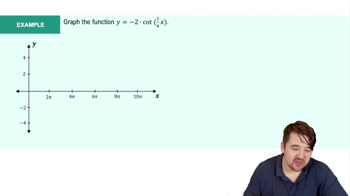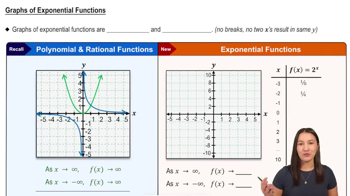Table of contents
- 0. Functions7h 52m
- Introduction to Functions16m
- Piecewise Functions10m
- Properties of Functions9m
- Common Functions1h 8m
- Transformations5m
- Combining Functions27m
- Exponent rules32m
- Exponential Functions28m
- Logarithmic Functions24m
- Properties of Logarithms34m
- Exponential & Logarithmic Equations35m
- Introduction to Trigonometric Functions38m
- Graphs of Trigonometric Functions44m
- Trigonometric Identities47m
- Inverse Trigonometric Functions48m
- 1. Limits and Continuity2h 2m
- 2. Intro to Derivatives1h 33m
- 3. Techniques of Differentiation3h 18m
- 4. Applications of Derivatives2h 38m
- 5. Graphical Applications of Derivatives6h 2m
- 6. Derivatives of Inverse, Exponential, & Logarithmic Functions2h 37m
- 7. Antiderivatives & Indefinite Integrals1h 26m
1. Limits and Continuity
Finding Limits Algebraically
Problem 74b
Textbook Question
Find the vertical asymptotes. For each vertical asymptote x = a, analyze lim x→a- f(x) and lim x→a+ f(x).
f(x) = x2(4x2 − √(16x4 + 1))
 Verified step by step guidance
Verified step by step guidance1
<Step 1: Identify the points where the function might have vertical asymptotes. These occur where the function is undefined or where the denominator is zero. In this case, since there is no denominator, we need to consider where the expression inside the square root becomes zero or negative.>
<Step 2: Analyze the expression inside the square root: \(16x^4 + 1\). Since this expression is always positive for all real \(x\), there are no points where the function is undefined due to the square root.>
<Step 3: Since the function \(f(x) = x^2(4x^2 - \sqrt{16x^4 + 1})\) does not have a denominator that can become zero, we need to consider the behavior of the function as \(x\) approaches infinity or negative infinity to check for vertical asymptotes.>
<Step 4: Evaluate the limits \(\lim_{x \to a^-} f(x)\) and \(\lim_{x \to a^+} f(x)\) for any potential vertical asymptotes. Since there are no points where the function is undefined, we focus on the behavior at infinity.>
<Step 5: Conclude that since there are no values of \(x\) that make the function undefined or cause a division by zero, there are no vertical asymptotes for this function.>
Recommended similar problem, with video answer:
 Verified Solution
Verified SolutionThis video solution was recommended by our tutors as helpful for the problem above
Video duration:
3mPlay a video:
Was this helpful?
Key Concepts
Here are the essential concepts you must grasp in order to answer the question correctly.
Vertical Asymptotes
Vertical asymptotes occur in a function when the output approaches infinity as the input approaches a certain value from either the left or the right. This typically happens at points where the function is undefined, often due to division by zero. Identifying these points is crucial for understanding the behavior of the function near those values.
Recommended video:

Introduction to Cotangent Graph Example 1
Limits
Limits are fundamental in calculus, representing the value that a function approaches as the input approaches a certain point. In the context of vertical asymptotes, evaluating the left-hand limit (lim x→a<sup>-</sup> f(x)) and the right-hand limit (lim x→a<sup>+</sup> f(x)) helps determine the behavior of the function near the asymptote, indicating whether it approaches positive or negative infinity.
Recommended video:

One-Sided Limits
Function Behavior
Understanding the behavior of a function involves analyzing how it changes as the input varies, particularly near critical points like vertical asymptotes. This includes observing trends such as increasing or decreasing values, and how the function behaves as it approaches the asymptote from either side, which is essential for sketching the graph and predicting the function's overall shape.
Recommended video:

Graphs of Exponential Functions

 5:21m
5:21mWatch next
Master Finding Limits by Direct Substitution with a bite sized video explanation from Callie
Start learningRelated Videos
Related Practice







